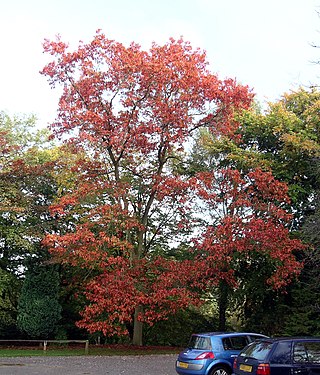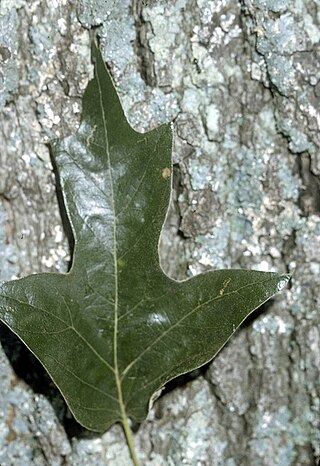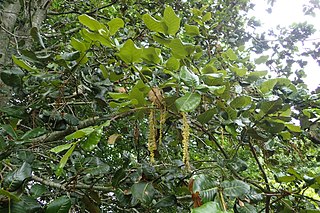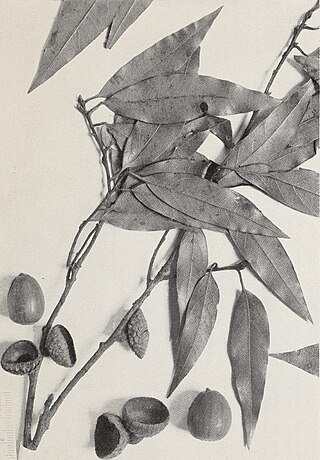
An oak is a hardwood tree or shrub in the genus Quercus of the beech family. They have spirally arranged leaves, often with lobed edges, and a nut called an acorn, borne in a cup. The genus is widely distributed in the Northern Hemisphere; it includes some 500 species, both deciduous and evergreen. Fossil oaks date back to the Middle Eocene. Molecular phylogeny shows that the genus is divided into Old World and New World clades, but many oak species hybridise freely, making the genus's history difficult to resolve.

Quercus rubra, the northern red oak, is an oak tree in the red oak group. It is a native of North America, in the eastern and central United States and southeast and south-central Canada. It has been introduced to small areas in Western Europe, where it can frequently be seen cultivated in gardens and parks. It prefers good soil that is slightly acidic. Often simply called red oak, northern red oak is so named to distinguish it from southern red oak (Q. falcata), also known as the Spanish oak. Northern red oak is sometimes called champion oak.

Quercus ilex, the evergreen oak, holly oak or holm oak is a large evergreen oak native to the Mediterranean region. It is a member of the Ilex section of the genus, with acorns that mature in a single summer.

Quercus petraea, commonly known as the sessile oak, Cornish oak, Irish Oak or durmast oak, is a species of oak tree native to most of Europe and into Anatolia and Iran. The sessile oak is the national tree of Ireland, and an unofficial emblem in Wales and Cornwall.

Quercus falcata, also called southern red oak, spanish oak, bottomland red oak or three-lobed red oak is an oak. Native to the southeastern United States, it gets its name the "Spanish Oak" as these are the areas of early Spanish colonies, whilst "southern red oak" comes from both its range and leaf color during late summer and fall. The southern red oak is a deciduous angiosperm, so has leaves that die after each growing period and come back in the next period of growth.

Quercus coccinea, the scarlet oak, is a deciduous tree in the red oak section Lobatae of the genus Quercus, in the family Fagaceae.

Quercus dentata, also called Japanese emperor oak or daimyo oak is a species of oak native to East Asia. The name of the tree is often translated as "sweet oak" in English to distinguish it from Western varieties. It is placed in section Quercus.

Quercus variabilis, the Chinese cork oak, is a species of oak in the section Quercus sect. Cerris, native to a wide area of eastern Asia in southern, central, and eastern China, Taiwan, Japan, and Korea.

Quercus faginea, the Portuguese oak, is a species of oak native to the western Mediterranean region in the Iberian Peninsula. Similar trees in the Atlas Mountains of northwest Africa are usually included in this species, or sometimes treated as a distinct species, Quercus tlemcenensis. It occurs in mountains from sea level to 1,900 metres above sea level, and flourishes in a variety of soils and climates. Out of all the oak forests in the Iberian Peninsula, the southern populations of Portuguese oak were found to have the highest diversity and endemism of spider species.

Quercus rotundifolia, the holm oak or ballota oak, is an evergreen oak native to the western Mediterranean region, with the majority on the Iberian Peninsula and minor populations in Northwest Africa. The species was first described by Jean-Baptiste Lamarck in 1785. It is the typical species of the Iberian dehesa or montado, where its sweet-astringent acorns are a source of food for livestock, particularly the Iberian pig. Its acorns have been used for human nourishment since the Neolithic era. It is placed in section Ilex. Some authors described it as a subspecies of Quercus ilex.

Quercus pyrenaica, also known as Pyrenean oak, or Spanish oak is a tree native to southwestern Europe and northwestern North Africa. Despite its common name, it is rarely found in the Pyrenees Mountains and is more abundant in northern Portugal and north and northwestern Spain.

Quercus semecarpifolia is an Asian species of oak. It is native to the Himalayas and nearby mountains in Tibet, Afghanistan, India, Nepal, and Pakistan, where it is referred to as kharsu. It is classified in subgenus Cerris, section Ilex.
Quercus motuoensis is an uncommon Asian species of trees in the beech family Fagaceae. It has been found only in Tibet, but may be extinct. It is placed in subgenus Cerris, section Cyclobalanopsis.
Quercus xanthotricha is an Asian species of tree in the beech family Fagaceae. It has been found in northern Indochina and in southern China (Yunnan). It is placed in subgenus Cerris, section Cyclobalanopsis.

Quercus spinosa is a species of oak native to central China, Taiwan and Myanmar, in the subgenus Cerris, section Ilex. An evergreen tree, its leaf traits may be adaptations to altitude. It is placed in section Ilex.

Quercus acatenangensis is species of oak. It is a tree native to mountains of Oaxaca and Chiapas states in southern Mexico, Guatemala, and El Salvador.
Quercus bawanglingensis is a species of oak. It is an evergreen tree native to the island of Hainan in southern China.
Quercus dongfangensis is a species of oak. It is a tree endemic to the island of Hainan in southern China. It grows in montane forests up to 1,500 meters elevation. Little is known about the population, habitat, or ecology of the species.
Quercus tiaoloshanica is a species of oak. It is a tree endemic to the island of Hainan. It is native montane forests between 900 and 1,400 meters elevation. It is recorded from only three locations, but its population, habitat, and ecology are not well understood.














